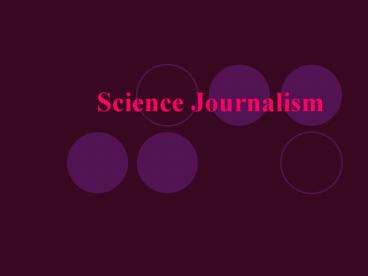Science Journalism - PowerPoint PPT Presentation
1 / 13
Title:
Science Journalism
Description:
Science journalism is a relatively new branch of journalism, which utilizes the ... areas: as a journalist, he must write well enough for magazines and ... – PowerPoint PPT presentation
Number of Views:150
Avg rating:3.0/5.0
Title: Science Journalism
1
- Science Journalism
2
- Science journalism is a relatively new branch of
journalism, which utilizes the art of reporting
to convey information on science topics to a
public forum.
3
- The communication of scientific knowledge via
mass media requires a special relationship
between the world of science and news media,
which is still just beginning to form.
4
- In recent years, the amount of scientific news
has grown rapidly with science playing an
increasingly central role in society. - Interaction between the scientific community and
news media has been therefore inevitable.
5
- The differences between the methodologies of
these two "pillars" of modern society, foremost
their distinct ways of developing their
realities, have led to some difficulties. - Science journalist is a journalist who
specializes in writing about science topics, and
thus exercises science journalism.
6
- Due to this combination, a science journalist
needs to be proficient in two areas as a
journalist, he must write well enough for
magazines and newspapers, and as an amateur
scientist, or at least as a dedicated learner
capable of following complex science and
explaining it in simple terms.
7
- Journalism ethics and standards include
principles of ethics and of good practice to
address the specific challenges faced by
professional journalists.
8
- Historically and currently these principles are
most widely known to journalists as their
professional "code of ethics" or the "canons of
journalism." The basic codes and canons commonly
appear in statements drafted by both professional
journalism associations and individual print,
broadcast, and online news organizations. - Every news organization has only its
credibility and reputation to rely on. - -Tony Burman, editor-in-chief of CBC News
9
- While various existing codes have some
differences, most share common elements including
the principles of truthfulness, accuracy,
objectivity, impartiality, fairness and public
accountability as these apply to the
acquisition of newsworthy information and its
subsequent reportage to the public.
10
- Like many broader ethical systems, journalism
ethics include the principle of "limitation of
harm." This often involves the withholding of
certain details from reports such as the names of
minor children, crime victims' names or
information not materially related to particular
news reports release of which might, for example,
harm
11
Development of Style
- 19th Century
- - serious and sensational form
- - fascinating but obscure, powerful but
dangerous - During World War I
- - increased publics awareness (social
econ. power of sc) and - - interest in science (sc prestige)
12
- 20th Century
- - enthusiasm but also antiscience tendencies
- - sc as an economic resource, instrument of
- progress, a servant of technological needs.
- - also as a guide to correct thinking and
appropriate behavior.
13
Changing Professional Ideals
- In 1960s
- - news articles more interpretive, investigative
and adversarial character - In 1970s
- - concern about social impact of ST
- - become critical investigators
- In 1980s
- - less critical more promotional style except
in disasters - - image sc as heroes, breakthroughs frontiers































